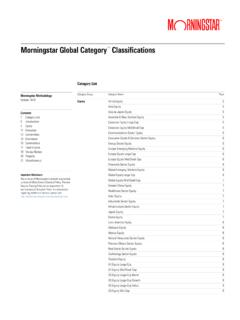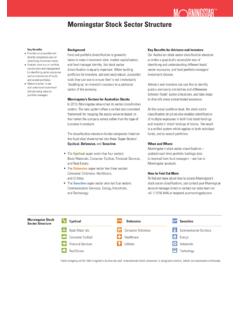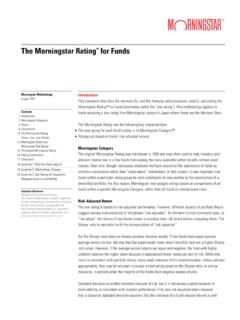Transcription of Morningstar Sustainability Rating Methodology
1 Morningstar Sustainability Rating Methodology Executive Summary The Morningstar Sustainability Rating is designed to support investors in evaluating the relative environmental, social, and governance risks within portfolios. Ratings are determined using bottom-up assessments of the underlying holdings within a portfolio, underpinned by Sustainalytics' methodologies for assessing corporate and sovereign ESG risk. The calculation of the Morningstar Sustainability Rating involves several steps to accurately represent the relative risk within each portfolio; however, the output of the Rating is a category of 1 to 5 "globes" for each eligible portfolio.
2 Introduction In 2016, Morningstar released the Morningstar Sustainability Rating to help investors evaluate portfolios on environmental, social, and governance factors. In several iterations, it has evolved to its current state where the Rating is considered a measure of the financially material ESG risks in a fund when compared with similar funds. The Methodology was updated in late 2021 to incorporate Sustainalytics Country Risk Ratings, which assess the risks to a sovereign entity s socioeconomic well-being by combining an assessment of the government entity s current stock of capital with an assessment of its ability to manage the wealth in a sustainable manner.
3 The Rating is calculated for managed products and indexes using Morningstar s portfolio holdings database. For each fund that is eligible for a Morningstar Sustainability Rating , the Rating is expressed as 1 to 5 globes, whereby a higher number of globes indicates that the portfolio has lower ESG Risk. Notably, the number of globes a fund receives is determined relative to other funds in the same Morningstar Global Category. This means that a fund could have more ESG risk than another fund yet still receive a better Rating if those funds are in different global categories, with their own unique qualification of what is a relatively low or relatively high amount of ESG risk.
4 Morningstar Research Sustainalytics Methodology & Portfolio Research 8 November 2021 Version Contents 1 Introduction 2 Rating Inputs 5 Rating Calculation 13 Frequency of Calculations Appendix 14 Glossary of Terms 17 Example Calculation 21 Rating Requirements Summary 23 References Authors Clark Barr Director, Methodology Sustainalytics Dayna Doman Data Director Morningstar Violet Redensek Data content Researcher Morningstar Morningstar Sustainability Rating Methodology | 8 November 2021 | See Important Disclosures at the end of this report. Page 2 of 24 Rating Inputs The Morningstar Sustainability Rating is calculated using Sustainalytics ESG Risk Ratings for corporate issuers and Sustainalytics Country Risk Ratings for sovereign issuers and is based on historical holdings.
5 Input #1: ESG Risk Ratings Sustainalytics ESG Risk Ratings measure the degree to which a company s economic value (enterprise value) is at risk driven by ESG factors or, more technically speaking, the magnitude of a company s unmanaged ESG risks. The Rating was created to provide investors with a signal that reflects to what degree their investments (single assets or portfolios) are exposed to ESG risks that are not sufficiently managed by companies. The overall unmanaged risk is measured by evaluating the company s ESG Exposure to and ESG Management of material ESG issues. For each issue, exposure can be broken between two types of risk, Manageable and Unmanageable risks.
6 Unmanageable risks are those risks that are outside the boundaries of a company management s control based on the assumption that the company continues its inherent business that is, doesn t fundamentally change what it is doing. For the portion that is manageable, a management assessment is applied based on the strength of company commitments, actions, and outcomes that demonstrate how well a company is managing the ESG exposure. The portion of manageable risk that is managed is considered Managed Risk, and the portion that is not managed is a Management Gap. Any risk to an ESG issue that is not properly managed by the company or that is unable to be managed by the company is considered Unmanaged Risk (see Exhibit 1).
7 The resulting measure of risk for each issue is summed to provide one score that represents the company s overall ESG risk. Exhibit 1 Combining Exposure and Management to Determine Unmanaged Risk Source: Sustainalytics The ESG Risk Ratings are considered an absolute risk assessment, which means that the output is comparable across sectors, industries, and subindustries as opposed to relative risk assessments, which calculate performance relative to peers and which may not be directly comparable to nonpeers. Based Morningstar Sustainability Rating Methodology | 8 November 2021 | See Important Disclosures at the end of this report.
8 Page 3 of 24 on the Unmanaged Risk scores, corporate entities are assigned to one of five ESG risk categories: Negligible, Low, Medium, High, and Severe. Company scores are dispersed across these categories when looking at Sustainalytics' global universe of over 12,000 companies. Medium risk (37%) is the most common risk category, with a moderate skew toward High risk (26%) and Severe risk (13%).
9 Exhibit 1 ESG Risk Ratings Category Distribution Source: Sustainalytics Input #2: Country Risk Ratings Sustainalytics' Country Risk Ratings assess the risks to a sovereign entity s socioeconomic well-being by combining an assessment of the government entity s current stock of capital with an assessment of its ability to manage the wealth in a sustainable manner. To quantify the amount of risk, the Rating combines two dimensions: Wealth and ESG Performance. Wealth reflects the vulnerability of a country in relation to ESG risks. It is measured as the value of assets within a country, as calculated by the World Bank.
10 The higher the Wealth of a country, the lower its vulnerability to ESG risks. The assets can be organized according to four distinct stocks of wealth: Natural Capital, Produced Capital, Human Capital, and Institutional Capital. Natural Capital is the stock of natural resources that provides inputs into economic activity as well as the ecological services upon which an economy depends. Produced Capital includes the stock of infrastructure, machinery, buildings, equipment, residential and nonresidential urban land, and so on that is produced through the economic activity of a region. Human Capital includes the stock of knowledge and skills among economic participants.







